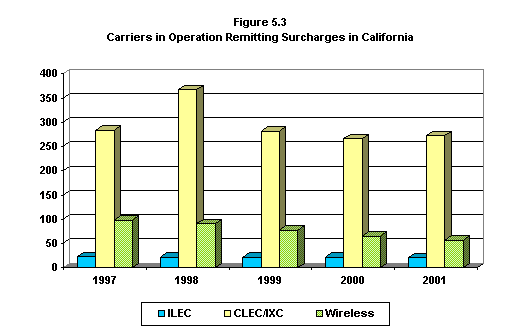A. Wireline License Applications Stable While Wireless in Decline
In gauging the state of competition in the telecommunications industry, staff examined how many new firms are entering and exiting the market each year.109 To gain a general picture of the potential (not actual) number of new carriers in a given year, staff considered the number of licenses granted to authorize service. In order to become a new telecommunications service provider in California, CLECs, IXCs and wireless110 carriers are required to obtain authorization from the CPUC. This authorization is called a Certificate of Public Convenience and Necessity (CPCN). Figure 5.1 shows that the total number of new wireline CPCNs rose until 1998, then reached a plateau, and remained stable at about 185 new licenses each year through 2000. 2001 has seen a severe decline in new CPCNs, perhaps due to the economic downturn that has affected the telecommunications industry nationwide. In the wireless market, the number of newly licensed carriers has been continually decreasing. It should be noted that the number of CPCNs overstates the number of actual entrants into the market. While wireline and wireless carriers are required to apply or register with the CPUC for authorization in order to begin providing any kind of service, many carriers choose not to initiate such service.

Source: Wireline and Wireless data derived from CPUC records of new carrier CPCNs and wireless registrations.
* Wireline applications consist of CLECs/IXCs, as no new ILECs have entered California in this time period.
The total number of carriers who have received authorizations to serve in the state has more than doubled since 1997, as detailed in Figure 5.2 below. Again, it should be noted that the authorization to provide service does not equate to the actual provision of service. By 2001 there were over 1,800 licensed carriers in California; however, far fewer are actually in operation. It is relatively easy and inexpensive for a qualified carrier, particularly one that is not building new facilities, to obtain authorization to provide telephone service. It is far more complex and expensive to actually provide telephone service, which, at a minimum, involves marketing, selling, and billing for services rendered.
Table 5.2: Licensed Telecommunications Carriers in California, 1996-2001*+ | |||||
1997 |
1998 |
1999 |
2000 |
2001+ | |
ILECs |
26 |
22 |
22 |
22 |
22 |
CLECs 111 |
104 |
209 |
256 |
303 |
350 |
IXCs 112 |
504 |
857 |
938 |
1018 |
1098 |
Wireless Carriers113 |
192 |
246 |
241 |
270 |
362 |
Total |
826 |
1,334 |
1,457 |
1,613 |
1,832 |
Source: Data taken from CPUC oracle database (UCS) on utility companies
* Total figures in Table 5.2 likely include significant double-counting, as many carriers (or their affiliates) are registered in 2 or more of the carrier groups, i.e. ILECs, CLECs, IXCs, and/or Wireless
+ Includes data through September 2001 only
B. Number of Carriers Remitting Surcharges
A better measure of the number of carriers actually participating in California's telecommunications markets is to examine data regarding surcharges that carriers are obligated to remit to the CPUC for public programs (such as lifeline service) each year. Because all carriers earning intrastate revenues are required to collect and remit surcharges, the number of carriers remitting surcharges provides an indication of the number of carriers actually serving customers. By this measure, as shown in the graph below, in 2001, there were 350 total carriers operating in California (21 ILECs, 272 CLECs/IXCs114, and 57 wireless carriers).

As shown in Figure 5.3, the number of ILECs remitting surcharges has remained fairly constant from 1997 to 2001, although, through mergers, their number has slightly decreased from 23 to 21 carriers. While the number of CLECs/IXCs grew initially after the local market was first opened in 1996, over the five-year period, the number of CLECs/IXCs has fallen slightly (283 in 1997 to 272 in 2001). In contrast, the number of wireless carriers remitting surcharges has decreased more significantly each year, from 98 in 1997 to only 57 in 2001, especially due to the decline in wireless resellers in California. While the number of wireless carriers in operation has declined, wireless retail revenues (as noted in Chapter 4) have increased. Those divergent trends are consistent with information presented in Chapter 4, that fewer carriers are collecting ever-increasing revenues, and thus an established core group of wireless providers prevails while weaker providers exit the market.
